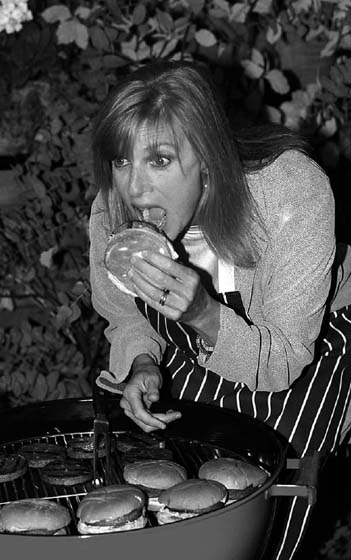The Encyclopedia of Dead Rock Stars (202 page)
Read The Encyclopedia of Dead Rock Stars Online
Authors: Jeremy Simmonds

‘Oh
shit
!’
Cozy Powell bids his girlfriend farewell

Cozy Powell puts his foot
Monday 6
Wendy O Williams
(Wendy Orlean Williams - Webster, New York, 28 May 1949)
The Plasmatics

The Queen of Shock Rock started as she intended to continue, a child-performer turned high-school rebel who seemed happiest either making as much noise as possible or disrobing in public – two traits she was to use to some effect in her career. Smalltime entrepreneur Rod Swenson (aka ‘Captain Kink’) liked what he saw when Williams showed up at his New York strip club in 1976, suggesting a marriage with the punk-rock vogue of the time. The Plasmatics were pure theatre – the band signed with UK label Stiff and debuted at CBGB’s to some response. With music very much taking a back seat, the band proceeded to blow up cars and take chainsaws to television sets in their low-concept stage act – Williams sported a Mohican, her breasts covered only by duct tape. Songs like ‘Butcher Baby’ and ‘Monkey Suit’ were largely an irrelevance, although the parent album,
New Hope for the
Wretched
(1980), sold initially. But once it became apparent that The Plasmatics were not likely to sell many more records, their act descended into low-rent pornography, and Williams was frequently arrested on obscenity charges. Post-Plasmatics, the singer found it harder to place herself, though she still somehow earned a Grammy nomination for the solo effort
WOW
(1985) and managed to land a few film roles.

Wendy O Williams: Taped before a live audience
Changing tack completely, Williams became an animal carer – an unlikely role that earned her the nickname ‘The Squirrel Lady’. But her career had been full of such anomalies and oddities; the ability to lead a normal life seemed beyond her. Finally, she was found in woods near her Connecticut home by lover Swenson, having shot herself in the head with a pistol. Williams’s longtime partner claimed that the former singer had been ready to die, having planned her suicide well in advance.
One of the singer’s better-known recordings was an unusual cover of ‘Stand by Your Man’, a 1982 duet with Motorhead’s Lemmy Kilmister. The song was, of course, the biggest hit of Tammy Wynette’s career – and, by remarkable coincidence …
Tammy Wynette
(Virginia Wynette Pugh - Itawambe County, Mississippi, 5 May 1942)

… from the disputed First Lady of Punk, to the undisputed First Lady of Country. Enduring a life of seemingly relentless pain – both emotional and physical – Tammy Wynette touched the lives of millions with her songs of feminine suffering. Brought up by her grandparents on a farm without electricity (her father had died of a brain tumour when she was an infant), the future star made her own entertainment, learning guitar and piano as well as taking singing lessons. Then, at the age of just seventeen, Wynette found herself in the first of five abusive marriages – to Euple Byrd, who dismissed her ambitions of being a singer with a curt ‘Dream on, baby!’ Their marriage lasted only six years but produced three children. A year after her divorce, Wynette graduated as a beautician before recording her first country tracks for Epic. By 1968 she had already cut her three best-known songs: ‘I Don’t Wanna Play House’, ‘DIVORCE’ and then, paradoxically, ‘Stand By Your Man’ – a song that apparently recommended that women forgive their philandering partners. Two more marriages – to Don Chapel in 1967 and singer George Jones two years later – saw her suffer further at partners’ hands (fists, in the case of the hard-drinking Jones), although she and Jones collaborated in the studio as the ‘King and Queen of Country’. Divorced again in 1975, Wynette then witnessed the irony of ‘Stand By Your Man’ being reissued to top the UK charts. And the soap opera of her personal life didn’t stop there. In 1976, the singer wed Nashville businessman Michael Tomlin. This time, the marriage (which had been hastily arranged, in any case) lasted less than two months; Wynette then found a fifth husband in songwriter and producer George Richey in 1978 – a union that was, somehow, to last the rest of her life. Aside from the rollercoaster ride of her love life, Wynette was also frequently unwell, filed for bankruptcy at least once and even suffered an abduction – which many, including her surviving daughters, believe may have been staged by Richey in order to conceal yet more signs of abuse.
In her career, Tammy Wynette recorded some fifty albums, enjoying seventeen country number ones. After a final, extraordinary crossover hit single with The KLF in ‘Justified and Ancient’ (1992, UK number two, number one in many other countries), Wynette withdrew from music, preferring to market her own jewellery. Having undergone some twenty operations in her time, she probably knew she was nearing the end. Surviving four days in a coma during 1994, Wynette’s body finally gave out in April 1998: the singer died lying on her sofa in the Nashville home that once belonged to Hank Williams Sr. Her memorial – televised live in the USA – was jam-packed with country luminaries, many of whom performed, including Merle Haggard, The Oak Ridge Boys and Dolly Parton.
Unhappy with the verdict of a blood clot as the cause of their mother’s death, Wynette’s daughters requested an exhumation of their mother’s corpse – buried without an autopsy – a year after her death. When this was refused, they hit both her physician (for over-prescribing strong medication) and Richey (for continuing to administer it, despite the chronic damage it was doing to her system) with $50 million lawsuits. Richey himself then filed for the body to be exhumed, in order to clear his name. With lawyers satisfied that the original verdict was correct, Richey then asked to
re-exhume
the body in 2004, in order to move it to the mausoleum that would contain his own remains on his passing. Even in death, Tammy Wynette may not rest in peace, it seems.
Friday 17
Linda McCartney
(Linda Louise Eastman - Scarsdale, New York, 24 September 1941)
Paul McCartney & Wings

A much-maligned figure in popular music, Linda McCartney was an accomplished rock photographer when she first encountered Paul at London’s Bag o’ Nails nightclub in 1967. One detail should be cleared up: McCartney was not, as is often misreported, any kind of heiress to the Eastman photographic dynasty, though she did have a privileged upbringing; her father (who oddly had changed his name from Epstein) was a successful business attorney. Marrying Paul McCartney in 1969 (he was her second husband, after geophysicist John Melvyn See, with whom she had one daughter), she was taught by him to play keys and joined Wings, the band Paul formed after the breakup of The Fab Four. Linda McCartney’s musical contribution to one of the seventies’ biggest bands is perhaps better left to one side, but she did co-write some of the group’s songs, and went on to record her own material, much of which appears on a posthumous album,
Wild Prairie
(1998). On top of this, McCartney kept herself busy with a series of photography books, as well as the campaign to encourage vegetarianism that prompted her ubiquitous frozen-food range.

Linda McCartney: Her produce has been sampled by many - even if her music hasn’t
‘The best tribute you can pay Linda? Go veggie.’
Paul McCartney, 1998
Mother to three more children, with the ex-Beatle (including renowned fashion designer Stella), Linda McCartney apparently never spent a night apart from her husband in twenty-nine years of marriage – save that brief spell while he was under investigation in Tokyo for marijuana possession. She learned of her breast cancer in 1997. Although it appeared at first that the disease was controllable, a recurrence early in 1998 suggested that the cancer had spread to her liver, and McCartney died soon after on her family’s ranch in Tucson, Arizona. Her memorial service in London drew the three surviving Beatles together for the first time since 1981.